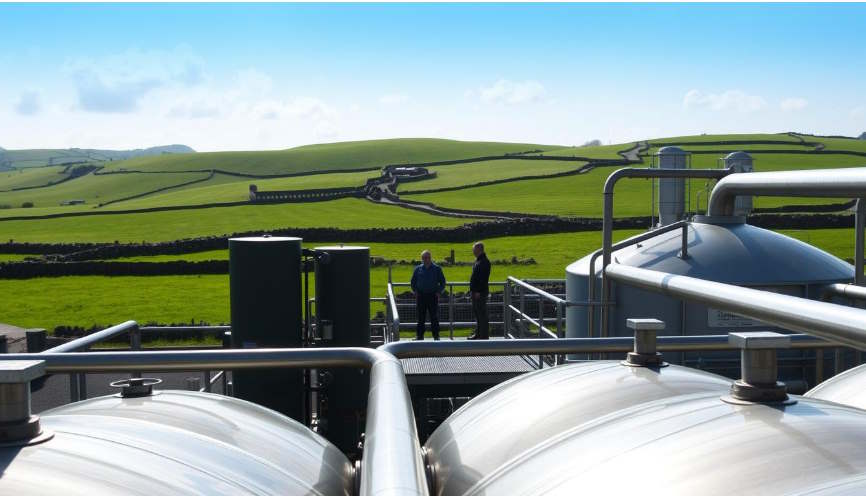
5 minute read
Discover Ireland's Anaerobic Digestion Facilities
Did you know that Ireland is home to only two operational anaerobic digestion plants injecting biomethane into the national gas network? This striking fact highlights the potential for growth in Ireland's renewable energy sector. Anaerobic digestion, a process that converts organic matter into biogas, plays a crucial role in sustainable energy production.
Leading companies like Carbery Group and Dairygold are pioneering this innovative approach, showcasing its real-world applications. These facilities not only contribute to energy efficiency but also align with Ireland's sustainability goals, making them a cornerstone of the country's environmental strategy.
As Ireland strives to meet its 2030 biomethane production targets, the significance of these plants becomes even more apparent. They exemplify how technological innovation can drive environmental benefits, marking a promising future for renewable energy in Ireland.
Key Takeaways
Ireland currently has two operational anaerobic digestion plants producing biomethane.
These plants contribute significantly to Ireland's renewable energy production and sustainability goals.
Leading companies such as Carbery Group and Dairygold are at the forefront of this innovation.
The country aims to increase biomethane production to meet future energy demands.
Anaerobic digestion facilities play a key role in Ireland's strategy to enhance energy efficiency and reduce environmental impact.
Introduction to Anaerobic Digestion in Ireland
Anaerobic digestion (AD) is a natural, biological process that converts organic matter into biogas, primarily consisting of methane and carbon dioxide. This process occurs in the absence of oxygen and is facilitated by microorganisms that break down organic materials like food waste and agricultural by-products.
What is Anaerobic Digestion?
Feedstock, the material used in AD, can include organic waste, food residues, and agricultural by-products. The process is particularly effective for managing organic waste, reducing landfill use and greenhouse gas emissions. In Ireland, AD has gained traction as a sustainable method to produce renewable energy while managing waste efficiently.
Historical Development and Key Milestones
The evolution of AD in Ireland reflects the country's growing commitment to renewable energy. Early projects, supported by initiatives like the Cork Chamber’s report, demonstrated the potential of AD to contribute to Ireland's energy goals. These pioneering efforts laid the foundation for modern AD plants, which now play a crucial role in the national renewable energy strategy.
Anaerobic digestion is not just a technology—it's a cornerstone of Ireland's sustainable future, bridging the gap between waste management and energy production.
Benefits and Challenges of Anaerobic Digestion
Anaerobic digestion offers a promising solution for sustainable energy production, but it also presents unique challenges. This section explores the economic and environmental benefits, while addressing the hurdles the sector faces.
Economic Impact and Cost Savings
The economic advantages of anaerobic digestion are significant. Facilities like those operated by Dairygold have reported notable cost savings. For instance, Dairygold's plant has reduced energy expenses by streamlining resource utilisation. This not only boosts the company's bottom line but also contributes to the broader economy. Additionally, the creation of jobs in plant operation and maintenance further stimulates local economies.
Environmental Emissions and Waste Treatment
From an environmental standpoint, anaerobic digestion excels in waste treatment. It effectively manages organic waste, diverting it from landfills and reducing greenhouse gas emissions. The process converts waste into biogas, which can be used as a renewable energy source. This dual benefit makes it a cornerstone of sustainable practices. However, managing emissions remains a challenge, requiring continuous process optimisation.
Industry Perspectives and Regulatory Considerations
Industry leaders highlight the importance of regulatory frameworks in shaping the sector's growth. Compliance with environmental standards is crucial for maintaining public trust and ensuring operational efficiency. While innovation drives progress, it must be balanced with adherence to regulations to avoid setbacks. The sector's growth is further supported by government incentives, such as feed-in tariffs, which encourage investment in anaerobic digestion projects.
Economic benefits include cost savings and job creation.
Environmental advantages involve waste reduction and lower emissions.
Regulatory compliance is essential for sustainable growth.
A serene, well-lit scene depicting the benefits of anaerobic digestion. In the foreground, a gleaming steel biogas plant stands proud, its sturdy construction and sleek design symbolizing the efficiency and reliability of the process. Swirling trails of biogas emanate from the plant, representing the valuable fuel it produces. In the middle ground, a lush, verdant landscape with thriving crops and livestock signifies the fertilizer and soil amendment benefits of the digestate. The background features a clear, blue sky with wispy clouds, conveying the environmental sustainability of this renewable energy solution. The overall mood is one of optimism, progress, and responsible resource utilization.
By addressing these aspects, anaerobic digestion continues to play a vital role in Ireland's renewable energy strategy, balancing economic growth with environmental stewardship.
Anaerobic Digestion Plants in Ireland
Ireland's biogas sector is growing, with several anaerobic digestion plants leading the way in sustainable energy production. These facilities are pivotal in reducing emissions and enhancing energy efficiency.
Spotlight on Established Facilities
Carbery Group and Dairygold are pioneers in this field. The Carbery Group's plant in West Cork stands out for its innovative approach, producing enough biogas to power over 7,500 homes annually. Dairygold's facility in Mallow, Cork, exemplifies efficient resource utilization, significantly cutting energy costs and supporting the local economy.
Emerging Examples Across the Country
Beyond these leaders, new plants are emerging. Kildare's 20-acre facility, approved by Kildare County Council, will process 165,000 tons of feedstock yearly, producing biogas for 7,500 homes and 145,000 tons of digestate for farmers. Other regions like Meath, Donegal, and Mayo are also seeing growth, with over 30 projects in planning stages.

